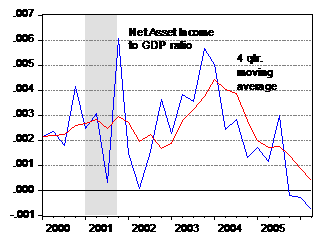According to the BEA current account release (discussed by Bloomberg here) for the second quarter, net asset-based income on a Balance of Payments basis has been negative for the past three quarters.
More specifically, 2005q4 was the first time (at least in the dataset extending back to 1967) this series breached zero; 2006q1 was the first time there were two consecutive negative readings. Figure 1 shows net asset based income, along with a 4-quarter moving average, both normalized by GDP.

Figure 1: Net asset based income receipts as a share of GDP. Source: BEA Sept. 18 current account release, St. Louis Fed FRED II, and author’s calculations.
A large component of this shift is due to the rising interest bill associated with US Government debt. Net interest payments to GDP, along with the 3 month T-bill rate, are displayed in Figure 2.

Figure 2: Net interest payments on US Government debt, as a share of GDP, and 3 month T-bill rate (secondary market); 2006q3 data for up to Sep. 18. Source: BEA Sept. 18 current account release, St. Louis Fed FRED II, and author’s calculations.
The main point that I draw from this graph is that interest payments on US Government debt are accelerating in volume, and with short term interest rates still rising, we should expect this ratio to rise again in 2006q3 — especially if GDP growth slows as anticipated in the current quarter. And as Brad Setser notes, if US government debt is longer term, then the immediate effects of the higher rates has been muted thus far. As world interest rates remain persistently high, a greater and greater proportion US debt will reflect these higher interest rates, imparting further upward pressure on this category.
So I’m betting on continued negative, or near zero, net asset-based income, on a BoP basis.
Technorati Tags: net factor payments,
interest rates,
current account deficit,
Balance of Payments
Menzie — what data series are you using for the US government debt payments. The one in the BEA release? That includes payments on both agencies and treasuries … which is important.
foreign purchases of treasuries have been very low in 06, but demand for agencies has been robust — so the stock is still rising.
that said, with more foreign demand for uS corporate debt (including MBS that are not guaranteed by Fanny/ Freddy), more and more of the net interest payments associated with rising US debt won’t show up in the gov. data series.
of course if errors and ommissions finance 1/4 of the deficit, that will help hold down net interest payments .. the US doesn’t have to pay interest on errors.
Menzi, so you have any data that demonstrates that the balance of payments has any effect on anything? I read a lot of press on how bad it is but I haven’t seen much data (actually none) supporting the assumption.
Brad Setser: I’m using line 33 minus line 16 (US Government (asset) payments minus US Government (asset) receipts) from the Current Account release to calculate net payments. I agree completely, these data show only part of the story regarding national — as opposed to Federal — interest payments.
Dick: I don’t think there is anything in the post that says the balance of payments is good or bad. To quote SecDef Rumsfeld, “It is what it is.” Rather, I’d say most importantly, the BoP accounts tells us what is going on in the economy, so trends in categories can signal what might happen. At the same time, in a world with rigidities, I’m not necessarily willing to side with former CEA chairman (under Reagan) Beryl Sprinkel who said the balance of payments is not a problem because it is always in balance. In a world with price and factor stickiness, asymmetric information, institutional rigidities (think hedge funds), and questions about financing, outsized current account imbalances might be a problem. So I don’t think ignorance is bliss, when it comes to the BoP.
uh, 2003: (1) WAR=”Borrow & Bleed” Republican Fiscal Policy; (2) OIL=commodity boom bubble ~ now bust; (3) post-9/11 “economic introspection”; eg.: selling housing/asset bubbles to one another (~20% of economy); crop rotation from traditional (largest historical export balancer) carbohydrates like wheat to Republican-subsidized corn & soybeans; and, “services”= chain stores selling mainly imported goods…
…and since ~2003, chain restaurants selling imported food products, out-pacing domestic food products/production for the first time: The new ASSEMBLY LINE is THE CHOW LINE at the FastFood Restaurant. Magnificent Taylorism!
The new ASSEMBLY LINE is THE CHECKOUT LINE at the BigBox CONSUMER ASSEMBLY PLANT, where YOU, THE CONSUMER, are assembled. You don’t BUY, you ARE SOLD. You’re not SPENDING, you ARE SAVING by “paying less.” uh-huh.
RE: “so [do] you have any data that demonstrates that the balance of payments has any effect on anything?”
…Balance of Payments = Current Account Deficit *IS* an EFFECT, not a CAUSE.
Menzie,
Sorry my first sentence sounded like a challenge. It should have read “do” rather than “so.”
Thanks for your response.